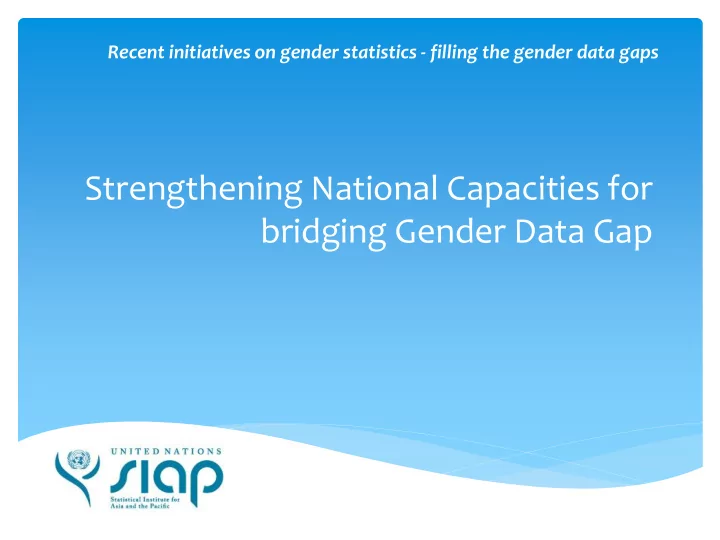

Recent initiatives on gender statistics - filling the gender data gaps Strengthening National Capacities for bridging Gender Data Gap
Monitoring discrimination against Women CEDAW in 1979 To measure the effect of policies and programmes Committee to monitor implementation of CEDAW All Censuses and Surveys to collect gender related data UNSC 2013 52 quantitative and 11 qualitative indicators Five domains Economic structures and access to resources Education Health and related services Public life and decision making Human rights of Women and children Indicators adopted in MDG and SDG monitoring 2
Task to be achieved All the countries in the region should be in a position to produce Sex disaggregated Indicators wherever relevant 40 Targets and 54 indicators related to gender equality SDG 5 : 80% indicators (13 out of 15 ) have accepted international standards Two indicators still in Tier III Hope these shall be developed in due course and would move from tier III to II and then I 3
Present Strategy of providing training on official statistics SIAP Training relating to Gender Statistics SIAP-JICA courses- Gender statistics is addressed Improving Capability in Producing Official Statistics for Monitoring the Post-2015 Sustainable Development Goals Production and Statistical Analysis of Monitoring Indicators in Support of Inclusive Development Policies- Small area estimation techniques Short courses Gender mainstreaming Policies for Government Officers Gender Statistics for two days 4
Areas where there is need for training Advocacy on use of Gender Statistics for policy formulation Diverse group of people to be engaged Ministries dealing with the policies relating to gender Civil Society Organizations Citizen’s group Academia Need Capacity building for appropriate use of data Making understand what kind of data available and how to use Analytical capacity building 5
Production of Statistics focused on gender Countries are at different stages on production of gender statistics Specialized areas Time Use survey Violence against women Gender related to environment and climate change Collection of data and also its interpretation and use Cultural sensitivity in collection of data Selection of enumerators and training Tools for analysis 6
Collaboration and Partnership Working with UN Women Setup a sub-group of The Network for the Coordination of Statistical Training in Asia and the Pacific To help in identification of training needs Develop curriculum for required training Develop content Develop course material suitable to mode of delivery of training Develop calendar of training regional, sub-regional and country level 7
Strategy for providing training on Gender Statistics Identification of experts for delivery of each different type of course Global list Country list 8
Strategy for providing training on Gender Statistics Development of Calendar of Training programmes SIAP Statistical Training Institutions in the region Identification of resources Development of course content Material for delivery of class room and e-learning courses Financial resources to organize training programmes Cost of participation of participants Organizing cost Cost of hiring experts 9
Role of UN Women and NSTIs for delivery of training programmes Role of UN Women Development of Course material Partner in delivery of training programmes Support to these activities Role of National Statistical Training Institutions Get commitment for organization of training programmes Arrange local participation Local logistics Local expertise Share Local practice in the relevant area 10
Strategy for providing training on Gender Statistics Address language related issues Seek support from concerned NSOs Translation of training material Delivery mechanism Face to face and e-learning 11
Thank you 12
Recommend
More recommend